CBSE Sample Papers for Class 10 Science Set-12
Class 10thCBSE Sample Papers for Class 10 Science Set-12
CBSE Sample Papers for Class 10 Science Set 12
Time: 3 Hours
Maximum Marks: 80
Instructions
- This question paper consists of 39 questions in 5 sections.
- All questions are compulsory. However, an internal choice is provided in some questions. A student is expected to attempt only one of these questions.
- Section A consists of 20 objective-type questions carrying 1 mark each.
- Section B consists of 6 Very Short questions carrying 2 marks each. Answers to these questions should be in the range of 30 to 50 words.
- Section C consists of 7 Short Answer type questions carrying 3 marks each. Answers to these questions should be in the range of 50 to 80 words.
- Section D consists of 3 Long Answer type questions carrying 5 marks each. Answers to these questions should be in the range of 80 to 120 words.
- Section E consists of 3 source-based/case-based units of assessment of 4 marks each with sub-parts.
Section A
Select and write the most appropriate option out of the four options given for each of the questions 1-20.
Question 1.
Which of the following two combinations is correct?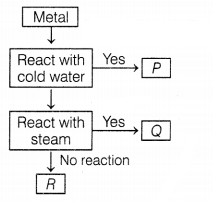
(a) P – Sodium, Q – Aluminium
(b) P – Aluminium, Q –
Zinc
(c) Q – Potassium, R – Lead
(d) Q – Copper, R – Silver
Answer:
(a) P – Sodium, Q – Aluminium
Metal like potassium and sodium reacts
violently with cold water.![]()
Metal like aluminium, iron, and zinc do not react either with cold or hot water.
They react with steam and form the metal oxide and hydrogen gas.
Lead, copper, silver, and gold do not react with water at
all.
Question 2.
A student learns that magnetic field strength around a bar
magnet is different at every point which of the following diagrams shows the
correct magnetic field lines around a bar magnet?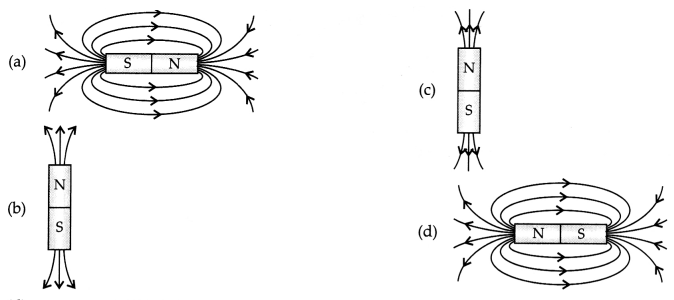
Answer: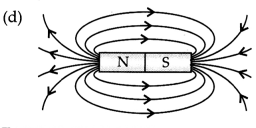
Explanation: The Magnetic lines of forces are continuous
curves and originate from the N-pole and end at the S-pole.
Question 3.
Chlorine forms a diatomic molecule, Cl2. The
electron dot structure for this molecule is



Answer:
In a chlorine molecule, both chlorine atoms contribute one
electron and thus, share a single electron pair to form a single covalent bond.
As electrons are shared by both atoms, they acquire the inert gas configuration
of the argon atom in the valence shell.
Question 4.
By removing the inducing magnets, the induced magnetism
is:
(a) Diminishes overtime
(b) Immediately diminishes
(c) It persists
for a significant duration
(d) It remains unchanged
Answer:
(b)
Immediately diminishes
Explanation: Induced magnetism takes place, as long as
the induced magnet is present.
Question 5.
Which of the following are the correct structural isomers of
butane?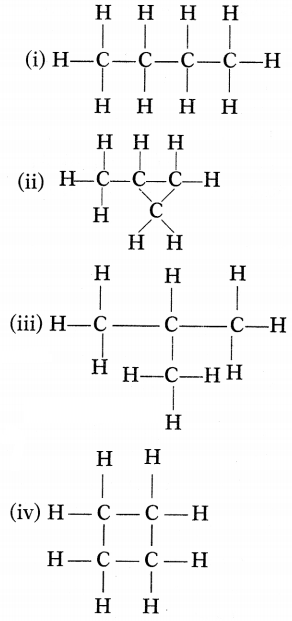
(a) (i) and (iii)
(b) (ii) and (iv)
(c) (i) and (ii)
(d) (iii) and
(iv)
Answer:
(a) (i) and (iii)
Structure (i) is n-butane. Structure
(iii) is iso-butane.
Since the molecular formula is the same, only the
structures are different. So, (i) and (iii) are isomers while structures (ii)
and (iv) have molecular formula C4H8.
Question 6.
Which among the following is not the function of the testes at
puberty?
(i) Formation of germ cells
(ii) Secretion of testosterone
(iii) Development of placenta
(iv) Secretion of estrogen
(a) (i) and
(ii)
(b) (ii) and (iii)
(c) (iii) and (iv)
(d) (i) and (iv)
Answer:
(c) (iii) and (iv)
Explanation: The development of the placenta
and secretion of estrogen are related to the female reproductive system and,
hence, are not the function of the testes at puberty.
Question 7.
Which of the following reactions involved the combination of
two elements?
(a) CaO + CO2 → CaCO3
(b) 4Na +
O2 → 2Na2O
(c) SO2 +
\(\frac{1}{2}\)O2 → SO3
(d) NH3 + HCl →
NH4Cl
Answer:
(b) 4Na + O2 → 2Na2O
In
this reaction, two elements sodium and oxygen participate and form sodium oxide.
However, in other reactions, the compounds are combined and form a single
product.
Question 8.
The process where characteristics are transmitted from parent
to offspring is called:
(a) Variation
(b) Heredity
(c) Gene
(d)
Allele
Answer:
(b) Heredity
Explanation: Characteristics from the
parents are passed down to the offspring during sexual reproduction. These are
the combinations of female and male parents. This is known as heredity.
Question 9.
Identify the phase of digestion which is represented in the
diagram in Amoeba. The arrow indicates the flow of stages of the nutrition
process.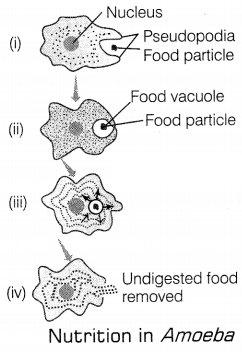
(a) The pseudopodia form the food vacuole for the egestion of undigested
food
(b) The pseudopodia fuses over the food particle forming a food vacuole
for the absorption of the food
(c) The pseudopodia forms the food vacuole for
the excretion
(d) The pseudopodia fuses over the nucleus forming a food
vacuole for the absorption of food
Answer:
(b) The pseudopodia fuses over
the food particle forming a food vacuole for the absorption of the food.
Amoeba takes in food using temporary finger-like extensions of the cell surface,
which fuse over the food particle forming a food vacuole. Inside the vacuole,
complex substances are broken down into simpler ones which then diffuse into the
cytoplasm, The remaining undigested material is moved to the surface of the cell
and thrown out.
Question 10.
A student wrote a chemical equation of the reaction between
carbon monoxide and hydrogen as,
CO2 + 2H2O →
CH3OH.
How can the reaction be classified?
(a) An example of a
combination reaction as a compound separated into two compounds.
(b) An
example of a decomposition reaction as a compound dissociates into two
compounds.
(c) An example of a combination reaction as two compounds react to
form a single compound.
(d) An example of a decomposition reaction as two
compounds react to form a single compound.
Answer:
(c) An example of a
combination reaction as two compounds react to form a single compound.
Explanation: The equation CO2 + 2H2O → CH3OH.
represents the combination of carbon monoxide (CO) and hydrogen (H2)
to produce methanol (CH3OH). The reactants (CO and H2)
combine to form a single compound, methanol. This reaction does not involve the
dissociation of any compound or the formation of multiple compounds.
Option (c) correctly states that the reaction is an example of a combination reaction as two compounds (carbon monoxide and hydrogen) react to form a single compound (methanol).
Option (a) Suggests that the reaction is a combination reaction, but it states that a compound separates into two compounds, which is not the case in this reaction.
Option (b) states that the reaction is a decomposition reaction, which is incorrect as it involves the formation of a compound, not the dissociation of a compound.
Option (d) also suggests a decomposition reaction, which is inaccurate for this particular equation.
Question 11.
What is the correct sequence of components of the reflex
arc?
(A) Sensory afferent nerve
(B) Relay neuron
(C) Motor nerve
(D)
Receptor organ
(E) Effector, e.g. muscle
(a) D → C → B → A → E
(b) D →
A → B → C → E
(c) E → B → E → A → D
(d) E → C → A → D → B
Answer:
(b) D → A → B → C → E
The sequence of events in the reflex arc is as
follows:
(D) Receptor organ-like skin perceives the stimulus and activates a
sensory nerve impulse.
(A) The sensory (afferent) nerve carries messages in
the form of sensory impulses to the spinal cord.
(B) The neurons of the
spinal cord (relay neurons) analyze sensory impulses and transmit them to motor
neurons.
(C) The Motor (efferent) nerve conducts these impulses from the
central nervous system to the effectors.
(E) Effector-like muscles respond by
pulling back the organ away from the stimulus.
Question 12.
Which of the following obeys Ohm’s law?
(a) Filament of a
bulb
(b) LED
(c) Nichrome
(d) Transistor
Answer:
(c) Nichrome
Explanation: In conductors, resistance remains constant when the current passing
through them is increased, they are known as Ohmic conductors. Nichrome which is
an alloy is made in such a way that its resistance remains constant for a wide
range of temperature. Hence, nichrome obeys Ohm’s Law. Whereas, transistors,
LEDs, and bulb filaments do not obey Ohm’s law because with the varied change in
temperature their resistance changes.
Question 13.
No matter how far you stand from a mirror, your image appears
erect. The mirror is likely to be
(a) plane
(b) concave
(c) convex
(d) either plane or convex
Answer:
(d) either plane or convex
Plane
mirrors and convex mirrors always form an erect image.
Question 14.
The electrical resistivity of an alloy of copper and nickel
is …………….. when compared with the electrical resistivity of an alloy of copper,
manganese, and nickel.
(a) same
(b) double
(c) more
(d) less
Answer:
(c) more
Explanation: The electrical resistivity of an alloy of
copper and nickel is greater when compared with the electrical resistivity of an
alloy of copper, manganese, and nickel. The electrical resistivity of Cu-Ni
alloys with increasing temperature rises steeply. At 200°C, the electrical
resistivity of Cu-Ni alloy is 49 × 10-8 Ω-m whereas of copper,
manganese, and nickel 44 × 10-8 Ω-m.
Question 15.
The main function of abscisic acid in plants is to
(a)
increase the length of cells
(b) promote cell division
(c) inhibit
growth
(d) promotes the growth of stems
Answer:
(c) inhibit growth
The main function of abscisic acid in plants is to inhibit growth.
Question 16.
A student has traced the path of a ray of light through a
glass slab as follows. If you are asked to label 1,2,3 and 4, the correct
sequencing of labeling ∠i, ∠e, ∠r and lateral displacement respectively is
: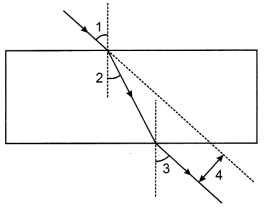
(a) 2, 1, 3, 4
(b) 1, 2, 3, 4
(c) 1, 3, 2, 4
(d) 1,
3, 4, 2
Answer:
(c) 1, 3, 2, 4
Explanation: Here, 1 is the angle of
incidence, 3 is the angle of emergence, 2 is the angle of refraction, and 4 is
the lateral displacement.
Directions (Q.Nos. 17-20) These consist of two statements – Assertion (A) and Reason (R). Answer these questions by selecting the appropriate option given below.
(a) Both A and R are true and R is the correct explanation of A.
(b) Both
A and R are true but R is not the correct explanation of A.
(c) A is true but
R is false.
(d) A is false but R is true.
Question 17.
Assertion (A): Denatured alcohol is not suitable for drinking
purposes.
Reason (R): Because denatured alcohol does not same taste and smell
as drinkable alcohol.
Answer:
(c) A is true, but R is false.
Denatured
alcohol is not suitable for drinking purposes because it contains some poisonous
substances like methanol, copper sulphate, etc. which results in coagulation of
protoplasm causing nausea, blindness, and even death. Hence, A is true but R is
false.
Question 18.
Assertion: It is possible to correct the refractive defects
with contact lenses or through surgical interventions.
Reason: The eye lens
is composed of fibrous jelly-like material.
Answer:
(b) Both A and R are
true and R is not the correct explanation of A
Explanation: The refractive
defects can be corrected by contact lenses and the eye lens is composed of
fibrous jelly-like material.
Question 19.
Assertion (A): Photosynthesis is the opposite biochemical
reaction of respiration.
Reason (R): Energy is utilized during
respiration.
Answer:
(c) A is true, but R is false.
Respiration is
defined as the process of biochemical oxidation of nutrients at the cellular
level during which energy is released whereas photosynthesis is the synthesis of
glucose molecules.
Question 20.
Assertion: The rate of photosynthesis will be lowered if the
leaves are coated with oil.
Reason: Stomata gets blocked and thus gaseous
exchange is affected.
Answer:
(a) Both A and R are true and R is the
correct explanation of A
Explanation: Stomata is a tiny pore in leaves that
helps in gaseous exchange, so if the stomata gets blocked due to oil, gaseous
exchange will be affected and hence the rate of photosynthesis gets lowered.
Section B
Questions No. 21 to 26 are Very Short Answer Questions.
Question 21.
Compound A oxidizes in the presence of a strong oxidizing
agent to produce an acid that is present in ants. Write the formula and IUPAC
names of both compounds. Give the formula and IUPAC names of the next two
members of their homologous series.
Answer:
CH3OH; IUPAC name –
Methanol
The general formula of an alcohol can be written as R—OH (where R is
an alkyl group).
Here, CH2 and (CH2)2 are
added to CH3OH, the next two members are
C2H5—OH; IUPAC name – Ethanol
C3H7—OH; IUPAC name – Propanol (1)
An acid present in
ants is HCOOH; IUPAC name – Methanoic acid
The next two members are (in the
same manner as before)
CH3COOH; IUPAC name – Ethanoic acid
C2H5—COOH; IUPAC name – Propanoic acid (1)
Question 22.
(i) One half of a convex lens of focal length 10 cm is
covered with black paper. Can such a lens produce an image of a complete object
placed at a distance of 30 cm from the lens? Draw a ray diagram to justify your
answer.
(ii) A 4 cm tall object is placed perpendicular to the principal axis
of a convex lens of focal length 20 cm. The distance of the object from the lens
is 15 cm. Find the nature, position, and size of the image.
Answer:
(i)
Yes, it can produce an image of a complete object placed 30 cm from the
lens.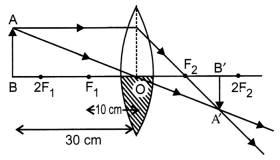
(ii) Given: h1 = 4 cm, f = + 20 cm, u = – 15
cm
We know that,
\(\frac{1}{f}=\frac{1}{υ}-\frac{1}{u}\)
⇒
\(\frac{1}{υ}=\frac{1}{f}+\frac{1}{u}=\frac{1}{20}-\frac{1}{15}=\frac{3-4}{60}=\frac{-1}{60}\)
∴ Image distance, υ = – 60 cm. The image will be virtual and erect.
Now,
Magnification, m = \(\frac{h_2}{h_1}=\frac{υ}{u}\)
⇒ h2 =
\(\frac{υ}{u}\) × h1 = \(\frac{-60}{-15}\) × 4 = + 16cm
Hence, an
erect and virtual image is formed having a size of 16 cm.
Question 23.
What is the role of leaves, glomerulus, and ureter in
excretion by various organisms?
Or
In birds and mammals, the left and
right sides of the heart are separated. Give reasons.
Answer:
Leaves:
Plants can accumulate some of their wastes in leaves. These leaves fall off and
the plant gets rid of the waste. (1)
Glomerulus: In nephrons, it filters the
blood passing through it.
Ureter: Transports urine from the kidney to the
urinary bladder. (1)
Or
The heart of mammals and birds is four-chambered.
It helps them in various ways as these are warm-blooded animals. Their
metabolism is complex and the body temperature is to be maintained throughout.
The separation keeps the oxygenated and deoxygenated blood away from the mixing,
allowing a highly efficient supply of oxygen to the body. (2)
Question 24.
A student is viewing under a microscope a permanent slide
showing various stages of asexual reproduction by budding in yeast. Draw a
diagram of what he observes in proper sequence.
Answer: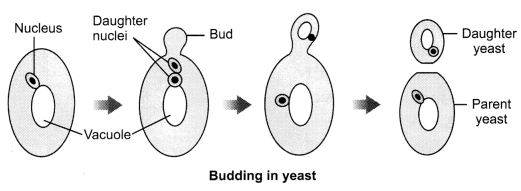
Question 25.
What are the advantages of connecting electrical appliances
in parallel with the battery instead of connecting them in series?
Or
In
the arrangement shown in the figure, there are two coils wound on a
non-conducting cylindrical rod. Initially, the key is not inserted in the
circuit. Later the key is inserted and then removed shortly after.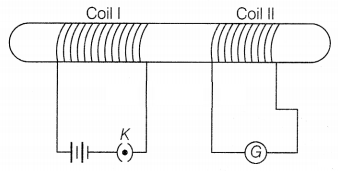
What are the two observations that can be noted from the galvanometer
reading?
Answer:
The following are the advantages of connecting electrical
devices in parallel with the battery:
(i) Parallel circuits divide the
current among the electrical devices so that they can have the necessary amount
of current to operate properly. (1)
(ii) If one of the devices in a parallel
combination fuses or fails, then the other devices keep working without being
affected. (1)
Or
The magnetic field lines around a straight
current-carrying conductor are concentric circles whose centers lie on the wire
(as shown in the figure).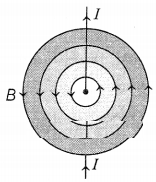
In the above figure, I and B represent the current and
magnetic field, respectively. (2)
Question 26.
What is ozone and how does it affect any ecosystem?
Answer:
Ozone is a triatomic molecule made of three oxygen atoms. It is
present as a layer in the stratosphere that prevents the harmful UV radiations
of the sun from entering the earth’s surface, thus protecting us from skin
cancers, genetic mutations, eye diseases like cataracts, etc. Ozone is a
molecule made from three atoms of oxygen.
Harmful chemicals like CFCs which are used as coolants in refrigerators, and air conditioners when released into the atmosphere break down the ozone thus leading to the depletion of the ozone layer. Hence harmful UV rays can easily pass through the ozone layer and cause various types of disorders in humans, plants, and animals.
Section C
Questions No. 27 to 33 are Short Answer Questions.
Question 27.
P, Q, and R are 3 elements that undergo chemical reactions
according to the following equations.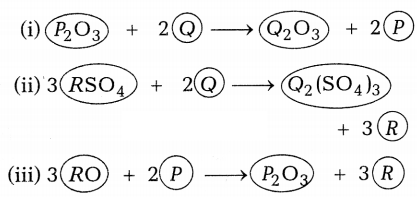
Answer the following questions.
(a) Which element is most reactive?
(b)
Which element is least reactive?
(c) State the type of reaction listed
above.
Answer:
(a) The most reactive element is Q as it has replaced both
P and R from their compounds.
(b) Element R is least reactive as it has been
replaced by both P and Q.
(c) Displacement reaction. (1 × 3)
Question 28.
The figure represents the human brain. Study the figure given
below and answer the following:
(i) Name the parts labeled (a), (b) and
(c)
(ii) Give one function of each parts labelled (a), (b) and (c)
(iii)
The largest part of the brain comprising two hemispheres is known as ……………..
.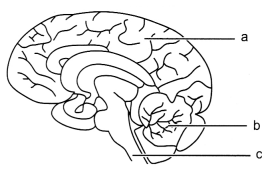
Study the diagrams given below and answer the following
questions: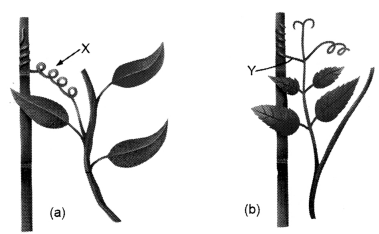
(i) Name the structures shown as X and Y in the figures (A)
and (B), respectively.
(ii) Write the functions performed by the structures X
and Y.
(iii) Name the phenomenon depicted and define it.
(iv) How do the
structures X and Y differ from each other?
(v) Give examples of the plants
which show the said phenomenon.
Answer:
(i) (a) – Cerebrum, (b) –
Cerebellum, (c) – Medulla oblongata
(ii) (a) Cerebrum is the seat of intelligence, memory, will power, and consciousness. It controls voluntary actions. It is the largest portion of the brain. It is divided into two halves called cerebral hemispheres which are connected by a sheet of fibres called the corpus callosum.
(b) Cerebellum controls and coordinates the muscular activity and maintains the posture and balance of the body.
(c) Medulla oblongata controls the functioning of internal organs and involuntary actions like the beating of heart, breathing movement, peristalsis movement etc.
(iii) The largest part of the brain comprising two hemispheres is known as
Cerebrum.
OR
(i) X: Stem tendrils, Y: Leaf tendrils.
(ii) Functions of
X and Y: Stem and leaf tendrils enable the plant to climb up support.
(iii)
Thigmotropism is depicted here in the figure. It is the growth movement of plant
parts in response to a touch stimulus.
(iv) Stem tendrils (X) arise from the
stem while leaf tendrils (Y) arise from the leaf of the plant.
(v) Sweet
peas, vines and Cuscuta.
Question 29.
Mustard was growing in two fields A and B. Field A produced
brown coloured seeds, while field B produced yellow-coloured seeds. It was
observed that in field A, the offspring showed only the parental trait for
consecutive generations, whereas in field B, the majority of the offspring
showed a variation in the progeny. What are the probable reasons for these?
Answer:
In field A, the reason for parental traits in consecutive generations
of the offspring is self-pollination. In self-pollination, the pollen from the
stamen of a flower is transferred to the stigma of the same flower. The parent
plant remains the same, so there will be no or very little variation seen.
(1)
In field B, variation is seen to occur because of the recombination of genes as cross-pollination takes place. In cross-pollination, the pollen from the stamen of a flower is transferred to the stigma of a different flower. There is a difference in the genetic material of the parents, therefore, the offspring shows variation. (2)
Question 30.
Why does micelle formation take place when soap is added to
water? Will a micelle be formed in other solvents such as ethanol also?
Answer:
Soap may be represented by the formula RCOONa where R is an alkyl
group that represents a long chain of carbon with fifteen or more atoms. Oil
drops containing dirt particles and water do not mix. Soap helps in their mixing
by reducing interfacial tension or friction. It forms a sort of bridge between
oil drops and water in which the alkyl portion (hydrophobic end) points towards
the oil drop while the other portion (hydrophilic end) is directed towards
water. This is known as micelle formation. Thus, soap helps in the formation of
a stable emulsion between oil and water. Ethanol and other similar solvents are
organic, and they do not help in micelle formation because soap is soluble in
them.
Question 31.
(a) In the figure below, a light ray travels from the air
into the semi-circular plastic block. Give a reason why the ray does not deviate
at the semi-circular boundary of the plastic block.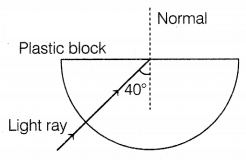
(b) Complete the ray diagram of the above scenario when the
light ray comes out of the plastic block from the top flat end.
Answer:
(a) The ray of light is undergoing normal incidence at the air-plastic block
interface. For normal incidence, there is no deviation. (1)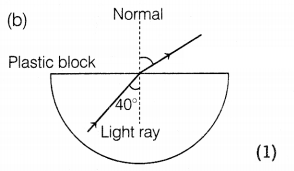
Question 32.
(i) How will you infer with the help of an experiment that
the same current flows through every part of a circuit containing three
resistors in series connected to a battery?
(ii) Consider the given circuit
and find the current flowing in the circuit and the potential difference across
the 15 Ω resistor when the circuit is closed.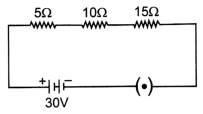
Answer:
(i) Let three resistors R1,
R2 and R3 be connected in series which are also connected
to a battery, an ammeter and a key as shown in the figure.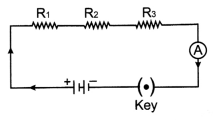
When the key is closed, an electric circuit is completed and
current starts flowing through the circuit. Take the reading of the ammeter. Now
change the position of the ammeter to anywhere in between the resistors and take
its reading. We will observe that in both cases reading of the ammeter will be
the same showing the same current flows through every part of the electric
circuit,
(ii) Given, R1 = 5 Ω, R2 = 10 Ω, R3 = 15 Ω,
V = 30 V
Total resistance, R = R1 + R2 +
R3
[As 5 Ω, 10 Ω, and 15 Ω are connected in series]
⇒ R = 5 +
10 + 15
⇒ R =30 Ω
Potential difference, V = 30 V
Current in the
circuit, I = ?
From Ohm’s law, I = \(\frac{V}{R}\)
⇒ I =
\(\frac{30}{30}\)
⇒ I = 1A
Therefore,
Current flowing in the circuit =
1 A
Potential difference across 15 Ω resistors = IR3 = 1 A × 15 Ω
= 15V
Question 33.
A student fixed a straight thick copper wire between two
terminals of a battery. He placed a magnetic compass near the current carrying
copper wire. Then, he observed that the position of the compass needle changed
slightly.
(a) What is the phenomenon by which the compass needle gets
deflected?
(b) What does the change in the position of the compass needle
indicate?
(c) If we change the direction of current through the wire, then
how does the position of the compass needle change?
Answer:
(a) When a
magnetic compass is placed near a current-carrying conductor, the position of
the compass needle changes. This phenomenon is known as the magnetic effect of
current. (1)
(b) The change in the position of the compass needle near a
current-carrying conductor indicates that a magnetic field is produced around
the conductor. (1)
(c) If we reverse the direction of current through the
wire, then the change observed in the position of the compass needle is also in
the opposite direction. (1)
Section D
Questions No. 34 to 36 are Long Answer Questions.
Question 34.
(i) A 10 cm tall object is placed perpendicular to the
principal axis of a convex lens of focal length 12 cm. The distance of the
object from the lens is 18 cm. Find the nature, position and size of the image
formed.
(ii) The absolute refractive index of Ruby is 1.7. Find the speed of
light in Ruby. The speed of light in vacuum is 3 × 108 m/s.
OR
A 6 cm tall object is placed perpendicular to the principal axis of a concave
mirror of a focal length of 30 cm. The distance of the object from the mirror is
45 cm. Use mirror formula to determine the position, nature and size of the
image formed. Also, draw a labelled ray the diagram to show the image formation
in this case
Answer:
(i) Height of object, h1 = + 10 cm
Focal length, f = + 12 cm
Object distance, u = – 18 cm
From the lens
formula,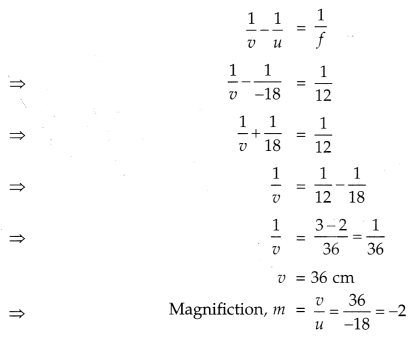
The position of the image formed is at a distance of 36 cm
from the convex lens.
(ii) We know that,
= 1.76 × 108 ms-1
Thus, the speed of
light in ruby is 1.76 × 108 ms-1
OR
Given the height
of the object = 6 cm
Focal length, f = – 30 cm
Object distance, u = – 45
cm
Image distance, υ =?
Height of image, hi = ?
We have,
\(\frac{1}{f}=\frac{1}{υ}+\frac{1}{u}\)
⇒
\(\frac{1}{-30}=\frac{1}{υ}+\frac{1}{-45}\)
⇒
\(\frac{-1}{30}+\frac{1}{45}=\frac{1}{υ}\)
⇒
\(\frac{1}{υ}=\frac{-3+2}{90}\)
⇒ υ = – 90 cm
Thus the image position is
at 90 cm on the same side of the mirror where the object is placed, we have
magnification (m),
⇒ m = \(\frac{h_i}{h_0}=\frac{-v}{u}\)
⇒
\(\frac{h_i}{6}=\frac{-(-90)}{-45}\)
⇒ \(\frac{h_i}{6}\) = – 2
⇒
hi = – 12 cm
Thus the height of the image formed is 12 cm.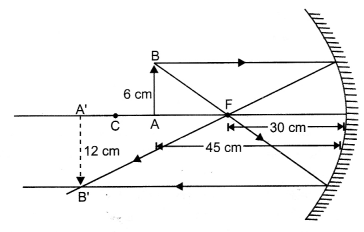
The image formed is real and inverted.
Question 35.
(a) Explain the barrier and chemical method of contraception
by giving an example of each.
(b) Explain the structure of the carpel with
the help of a labelled diagram.
Or
(a) Compare and contrast nervous and
hormonal mechanisms for control and coordination in animals.
(b) How does
chemical coordination occur in plants?
Answer:
(a) (i) Barrier method: It
involves the usage of certain products or devices that prevent the meeting of
gametes and help in birth control, e.g. condom, diaphragm, etc. (1)
(ii)
Chemical method: It involves the usage of chemicals called spermicides, which
are applied in the vagina to kill sperm. It can only be used with condoms or
diaphragm (1)
(b) Carpel or Pistil is the female reproductive part and is present in the centre of a flower. It is made up of the following three parts:
- Stigma: the sticky terminal part of the carpel which helps in receiving the pollen grains.
- Style: the middle elongated part of the carpel which helps in the attachment of stigma to the ovary.
- Ovary: the swollen bottom part of the carpel which contains ovules having an egg cell.
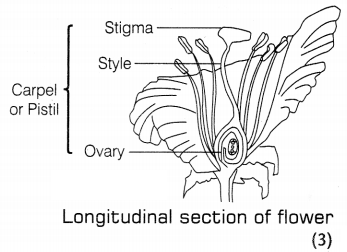
Or
(a) Comparison between hormonal mechanisms are as follows:
| Basis | Hormonal Mechanism/Endocrine System | Nervous Mechanism |
| Passage of information | It is through chemicals called hormones. | It is through electrical conduction. |
| Sensory Receptors | Absent | Present |
| Rapidity | The system is comparatively slower. | The system is rapid. |
| Connection | The system is not connected to target sites directly. | The system is directly connected to every part under its control. |
| Response | The response is slow and produced by all the cells of the target tissues. | The response is quick and limited to those cells that are innervated with nerves. |
| Role in growth and development | The system controls growth and development. | It has little role in growth and development. |
| Components | It consists of glands and their secretions. | It consists of neurons, nerves, and nervous organs. |
| Effects | The effect of chemical messages lasts for a longer period. | The effect of a nervous message is for a short duration. |
| Action | It is involuntary. | It can be voluntary or involuntary. |
(b) Chemical coordination in plants is achieved by the plant hormones. Plant hormones are the chemical compounds, which help the plant to coordinate the growth, development, and responses to the environment. The plant contains the following plant hormones:
- Auxins help in cell elongation.
- Gibberellins help in the growth of the stem.
- Cytokinins promote cell division.
- Abscisic acid inhibits plant growth. (2)
Question 36.
Describe the alimentary canal of human beings.
OR
Describe the internal structure of the human heart.
Answer:
The alimentary
canal of human beings starts with the mouth and ends at the anus.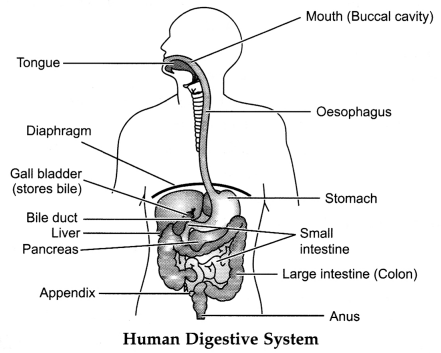
(1) Mouth: We ingest food through the mouth. Teeth are
present in the mouth which helps in chewing and mastication of food. Tongue
helps in mixing food with saliva. Mouth has salivary glands which secrete
saliva. Saliva contains the enzyme ptyalin or salivary amylase which helps in
breaking down complex food (starch) into simpler substances.
(2) Oesophagus: The food in the form of bolus passes from mouth to stomach through the oesophagus by peristalsis. It acts as a passage of food from mouth to the stomach.
(3) Stomach: Stomach is a J shaped bag like structure. Gastric glands present in stomach secrete gastric juice. Gastric juice contains HCl, mucus and enzyme pepsin. Pepsin is a protein digestive enzyme. Food in the form of chime passes to small intestine.
(4) Small intestine: It is the longest part of the alimentary canal with many folds. It is a coiled like structure. It secretes intestinal juice which contains many enzymes like amylase, lipase, maltase, lactase etc. The complete digestion of food occurs in small intestine. It contains finger like projections called villi which absorb the digested food. It receives pancreatic juice from pancreas and bile juice from liver for digestion of fats, carbohydrates and proteins.
(5) Large intestine: It receives undigested and unabsorbed food from the
small intestine. Most of the water is absorbed here and the remaining is
converted into a semi-solid waste material called faece. The faecal matter is
stored in rectum and is removed through the anus from time to time.
OR
(1)
Human heart is four-chambered. It consists of two upper chambers called auricles
or atrium and two lower chambers called ventricles.
(2) The right atrium receives deoxygenated blood from all parts of the body through two venacava – superior and inferior venacava. The opening between right atrium and the right ventricle is guarded by tricuspid valve which prevents back flow of blood.
(3) Pulmonary artery carries deoxygenated blood from right ventricle to the lungs for oxygenation.
(4) Left atrium receives oxygenated blood from lungs through pulmonary veins. The opening of left atrium and left ventricle is guarded by bicuspid valve.
(5) From the left ventricle, aorta arises which carries oxygenated blood to the whole parts of the body.
(6) Human heart is enclosed by the pericardium membrane.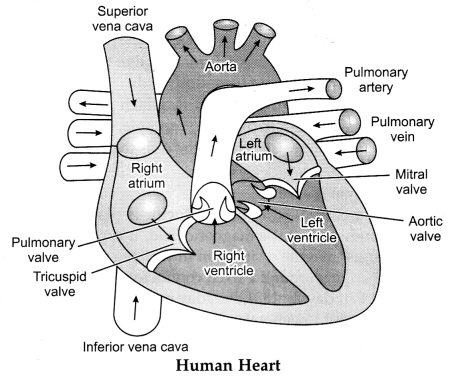
Section E
Questions No. 37 to 39 are case-based/data-based questions with 2 to 3 short sub-parts. Internal choice is provided in one of these sub-parts.
Question 37.
The table given below shows the hints given by the quiz
master in a quiz.
| Hints |
| (i) Compound ‘A’ is widely used as a preservative in pickles. |
| (ii) ‘A reacts with ethanol to form a sweet-smelling compound ‘S’. |
Based on the above hints answer the following questions.
(a) Identify the
compound A and compound B.
(b) Which gas is produced when compound ‘A’ reacts
with washing soda? Write the chemical equation.
Or
How can we get the
sodium salt of compound A from compound B? Name the process and write the
corresponding chemical equation.
Answer:
(a) A = Ethanoic acid, B = Ester
(2)
(b) CO2 gas is produced.
Or
The sodium salt of the compound ‘A’ can be obtained from compound ‘B’ by
the action of a base. This process is called saponification.
Question 38.
When growing plants detect light, a hormone called auxin, is
synthesized at the shoot tip, which helps the cells to grow longer. When light
is coming from one side of the plant, auxin diffuses towards the shady side of
the shoot. This concentration of auxin stimulates the cells to grow longer on
the side of the shoot which is away from light. Thus, the plant appears to bend
towards the light. Other examples of plant hormones are gibberellins which, like
auxins, help in the growth of the stem. Cytokinins promote cell division, and it
is natural then that they are present in greater concentration in areas of rapid
cell division, such as in fruits and seeds. These are examples of plant hormones
that help in promoting growth. But plants also need signals to stop growing.
Abscisic acid is one example of a hormone that inhibits growth. Its effects
include wilting of leaves.
(a) What is the function of cytokines?
(b) What are plant growth
inhibitors? Give an example.
(c) Where is auxin synthesized?
OR
What is
the function of gibberellins?
Answer:
(a) Cytokinins promote cell
division, and it is natural then that they are present in greater concentration
in areas of rapid cell division, such as in fruits and seeds.
(b) Plant
growth inhibitors are regulating substances which retard such processes as root
and stem elongation, seed germination, and bud opening. For example, Abscisic
acid.
(c) Auxin is synthesized at the shoot tip and helps the cells to grow
longer.
OR
Gibberellins help in the growth of the stem.
Question 39.
A student experiments and plots the V-I graph of a sample of
nichrome wire at three temperatures T1, T2, and
T3 as shown in the figure.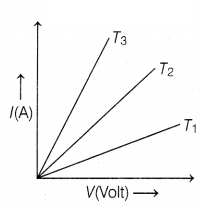
(a) Which temperature, V-I graph obeys Ohm’s law?
(b)
Which temperature, the resistance of nichrome wire is minimum?
(c) What is
the correct relation among temperatures T1, T2, and
T3?
Or
Give two examples of the application of the heating
effect of electric current.
Answer:
(a) The V-I curve of a given wire at
temperatures T1, T2, and T3 obeys Ohm’s law
because each V-I curve is a straight line. (1)
(b) Resistance of nichrome
wire is directly proportional to temperature. Since, T1 <
T2 < T3, hence, resistance of nichrome wire is minimum
at temperature T1. (1)
(c) The slope of the V-I graph for the
nichrome wire is directly proportional to its temperature. Hence, correct
relation among T1, T2 and T3 is given as
T3 > T2 > T1 (2)
Or
Electric iron
and electric bulbs are two examples of the application of the heating effect of
electric current. (2)